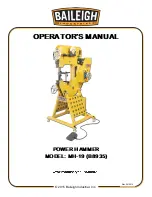
17
Operation
17
Concrete
Blade should be bevel up when working over concrete. Pretty much anything over con-
crete works. Try different setups to see which works best. If goods come up difficult, the
slide plate should be at a low setting, 1” (2.5 cm) off the floor. Use a smaller size blade. If
goods come up easily, a wider blade can be used.
Wood Sub-Floor
A heavy machine cannot be used on wood subfloors or raised panel computer floors.
Keep machine light; remove all weights. A weighted machine could break through the
floor. The slide plate should be adjusted to a low setting, 1” (2.5 cm) off the floor. Blades
should be as flat of an angle as possible. Use a heavy duty blade (these blades have
a bend to them) or a regular blade bevel down. When using a regular blade, bending
up the corners of the blade will help from the blade digging into the floor. Sometimes a
shank blade or a shank blade with a carbide tip will work. Allow blade to shear material
from the floor. The trick on wood floors is to run the blade flat. Approach should be at a
45° angle to the board. This keeps from digging into the board and hanging up at the
seams.
Soft Sub-Floor
The slide plate should be adjusted to a low setting 1” (2.5 cm) off the floor. Blades should
be as flat of an angle as possible. Use a heavy duty blade (these blades have a bend to
them) or a regular blade bevel down. When using a regular blade, bending up the cor-
ners of the blade will help from the blade digging into the floor. Sometimes a shank blade
or a shank blade with a carbide tip will work.
DITCHING
Cross Room Ditching (Figure 21)
When removing hard to remove ceramic, VCT, or VAT, cross-room ditching will help to
make the removal easier. Using a blade 2”-6” (5-15 cm) in width, make ditches 1’-2’ (30-
60 cm) apart in the same direction the machine will be removing the goods. This relieves
the pressure holding the tiles together. If ditching helps and the goods are coming up
easy, try using a wider blade to ditch with.
Checkerboard Ditching (Figure 22)
To make carpet removal and debris clean-up easier, checkerboard ditching is very help-
ful. Using as wide of a self-scoring blade as possible, make ditches 4’-6’ (1.25-1.75 m)
crossways from the way the machine will be removing the goods. Running the machine
crossways from the ditches will make smaller pieces of debris to be hauled away. Instead
of large gummy rolls of carpet, there are small squares that can be rolled, palletized, put
on a dolly, or folded with the sticky side in. This makes removing the debris easier and
reduces the amount of debris.
HEADLIGHT
The headlight illuminates the work zone.
• Use the toggle switch to turn the headlight ON and OFF.
NOTE: The headlight only
operates when the machine is running.
•
The light is fixed-mounted with fixed brightness--it is not adjustable.
CROSS-ROOM DITCHING
Ditch
2”-6”
Blade
Tile
1’-2’
Strips
Figure 21
Run the machine the same direction
that the ditches are made
Carpet 4’-6’
apart
Use as
large of a
blade as
possible for
ditch
Figure 22
Run the machine crossways from the
directions that the ditches are made
CHECKERBOARD DITCHING
401809_5700_RevR
To
order
go
to
Discount-Equipment.com
















































